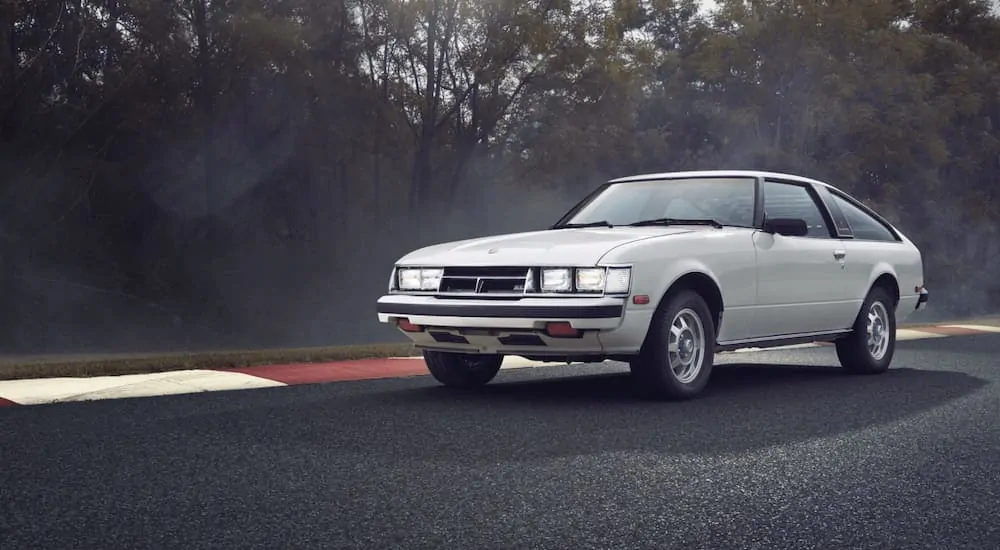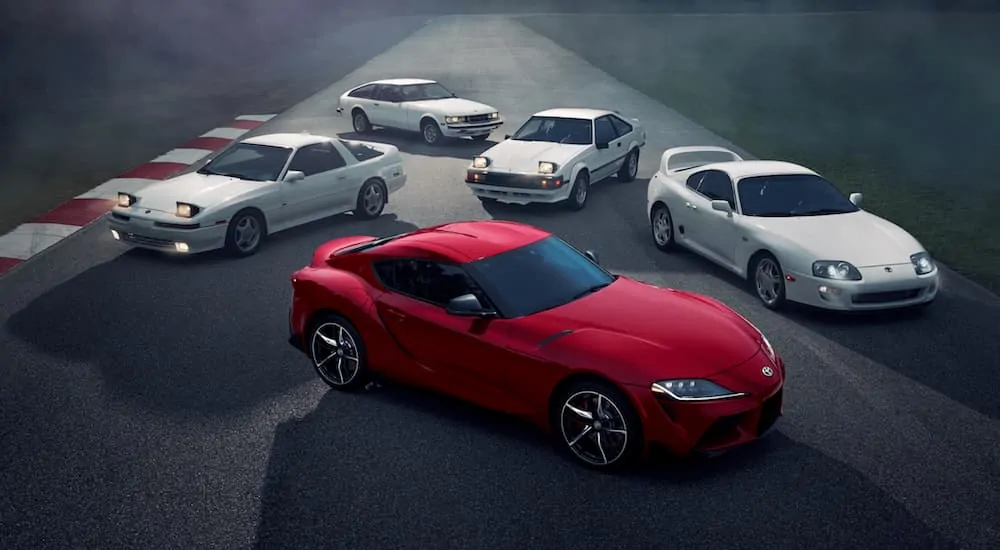When most people think of a Toyota, the first thing to come to mind is a reliable, family-oriented vehicle, such as a Camry or RAV4. But when it comes to a model that will get the pulse racing and raise the question, “where’s the closest Toyota dealer near me?” The standout model is, without doubt, the Toyota Supra. Since its introduction in 1979, this sports car has held its own in a market typically dominated by Corvettes and Porches, gaining notoriety in the Gran Turismo video games, and enjoying starring roles in The Fast and The Furious franchise.
The 2020 GR Supra represents the first model in the fifth generation of this famed two-seater sports car, and like its predecessors, there’s plenty to like. But for Supra purists, how does it stand up to the classic generations that came before? The market hasn’t seen a Supra since 2002, so what has changed, and more importantly, what has been improved? Take a look at some of the classic versions of the Supra, and compare with the 2020 GR release to determine which version of this now-classic sports car you’d prefer to take for a long drive on a bright, sunny day.
A Grand History
The first Supra was known as the “Celica Supra,” as it was largely based off the Toyota Celica. Except this version was larger and more powerful than its sibling, with a 2.6-liter inline-6 engine that pioneered Toyota’s use of the electronic fuel injection model. With a choice of manual or automatic transmission, features such as independent suspension and disc brakes on all four wheels made it an instant hit for thrill-seeking drivers.
In the early years of the 1980s, the Celica Supra was divided into two distinct model types. The P-type stood for “Performance Type,” and featured fiberglass fender flares over the wheel wells, eight-way adjustable sport seats, and a manual transmission. The L-type was the “Luxury Type,” which featured an automatic transmission, leather seats, and a digital dash with a trip computer. The L-type was discontinued in 1986.

The Toyota Celica and Toyota Supra became fully separate models in 1986, with the Celica maintaining its reputation as a front-wheel drive coupe, while the Supra took on an identity as a rear-wheel drive sports beast. Third generation Supras include a 3.0L DOHC inline-six engine that offered 200 horsepower, a removable sport roof to let the wind blow. In 1987, anti-lock brakes and a turbo-charged engine rounded out the package.
The fourth generation appeared in 1993, with an even bolder stance towards high performance. Toyota’s goal was to create a lean, mean beast of a machine, so measures were taken to reduce the overall weight of the vehicle while increasing the overall horsepower up to 320. Throughout this generation, major changes included a re-introduction of the six-speed manual transmission, an automatic transmission with optional manual shift mode, graphite accents, a stronger frame, and sound-dampening construction. Alas, as trends moved away from high-performance cars, as the year 2000 approached, the Supra was quietly discontinued in the North American market.
The Latest Generation
Twenty years later, the tides have turned, and the market seems more ready than ever for a sports car that is fun, powerful, and over $10,000 less expensive than its competitors. With great fanfare, the 2020 Toyota GR Supra marked the entrance of the fifth generation to a market of eager supporters.
Just a glance at the new Supra is enough to know that this vehicle is very, very cool. Its sleek design includes much of the shape and essence of its older siblings, only with a new aerodynamic shape that manages to be simultaneously sexy and athletic.
The 2020 GR Supra has been released in three trims: the 3.0, the 3.0 Premium, and the highly limited Launch Edition. Each vehicle is equipped with a powerful 3.0L inline-six engine, matched with an eight-speed automatic transmission. The Supra retains its rear-wheel drive identity from earlier generations, too. Together, this package offers 335 horsepower and 365 lb-ft of torque, with a very reasonable fuel economy of 24 MPG in the city, 31 MPG on the highway, and 26 MPG combined.
The “base” 3.0 model starts at an MSRP of $49,990 and is a sporty and majestic addition to any car enthusiast’s collection. From its 19-inch forged aluminum wheels to its seven-liter glove box, every detail of this vehicle is designed for pure fun. Inside, drivers will enjoy black Alcantara leather-trimmed sport seats, automatic dual climate control, and a comprehensive information/entertainment system, the Supra Command. With features like a 6.5-inch display screen, AM/FM radio, digital audio, SiriusXM, and USB/Bluetooth wireless connectivity, drivers can remain connected while enjoying all their favorite tunes. Smart Key entry and start, auto-dimming rearview mirror, and automatic rain-sensing windshield wipers are just a few of the convenience features that will keep drivers enjoying the drive at all times.
The 3.0 Premium starts at an MSRP of $53,990 and takes the fun, sporty Supra lifestyle to the next level. With black leather trimmed seats and sport pedals, the cabin has a real racecar-type feel. Equipped with a 12 speaker JBL surround sound system, SiriusXM, Apple CarPlay compatibility, and wireless Bluetooth connectivity, your tunes will sound amazing as you zip around tight turns and let it all out on the freeway. The Toyota Supra Connect system is available on the Premium, as well, featuring such capabilities as emergency calling, battery guard, remote locking and ventilation, real-time traffic details, and concierge service. A wireless charging tray ensures you never lose contact with reality even if you want to.
Only 1,500 Launch Edition models will be available. With an MSRP of $55,250, the Launch Edition GR Supra is available in Renaissance Red, Nocturnal Black, and Absolute Zero White paint colors, with red accent heated auto-heated outside mirrors and matte black 19-inch wheels. Inside, drivers will have a choice of black or red leather trimmed sport seats. Inside a signed serial number identifies each Launch Edition model.
Comparison at a Glance
One main difference between the earlier generations of Supra and today’s GR Supra is the safety features. All trim levels of the 2020 Toyota feature front, side, curtain, and knee airbags, along with anti-lock brakes, traction control, and electronic vehicle stability control. More modern safety features include a pre-collision system with pedestrian detection and a rearview camera to mitigate impact with objects when traveling forward or in reverse. Lane departure warning with steering assistance ensures drivers stay in their lane, while automatic high beams provide courtesy and safety to other drivers at night.
When it comes to power, however, the early Supras and the newest generation are actually quite similar. For example, the 1993 Supra sported a 3.0L Twin Turbo I6 engine, while the 2020 has a 3.0L Turbo I6. The ‘93 offered 320 horsepower and 315 lb-ft of torque, and the ‘20 only slightly surpasses this at 335 horsepower and 365 lb-ft of torque. The new Supra is less than 100 pounds lighter, at 3,397 lbs versus the 1993 model’s 3,485 lbs, too.
While this doesn’t seem like an “improvement,” the new generation of the Toyota Supra isn’t about making a great thing better––it’s about bringing a great vehicle back to life. With BMW-inspired engineering and impeccable styling, the urge to climb behind the wheel is going to be strong for those with a need for speed. Loads of features that promote safety and fun only sweeten the deal, with plenty of options that will encourage drivers to stay on the road as long as possible.





